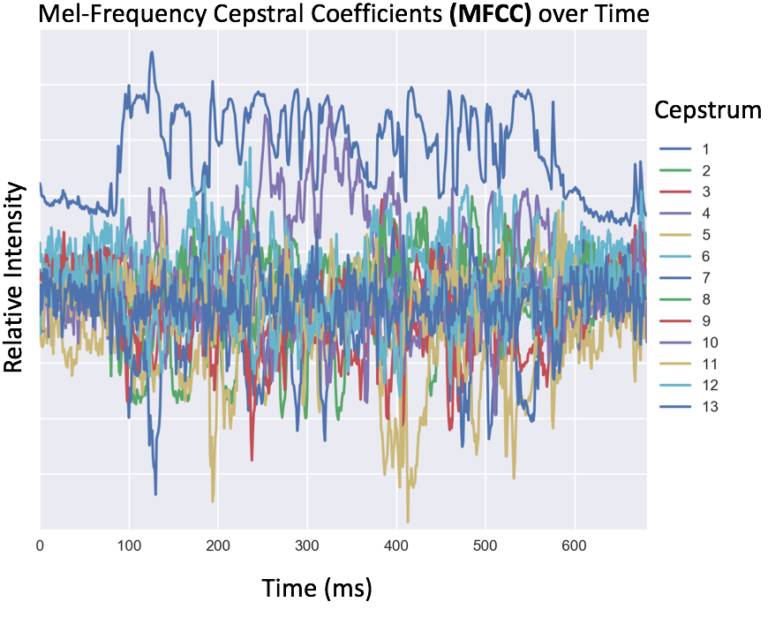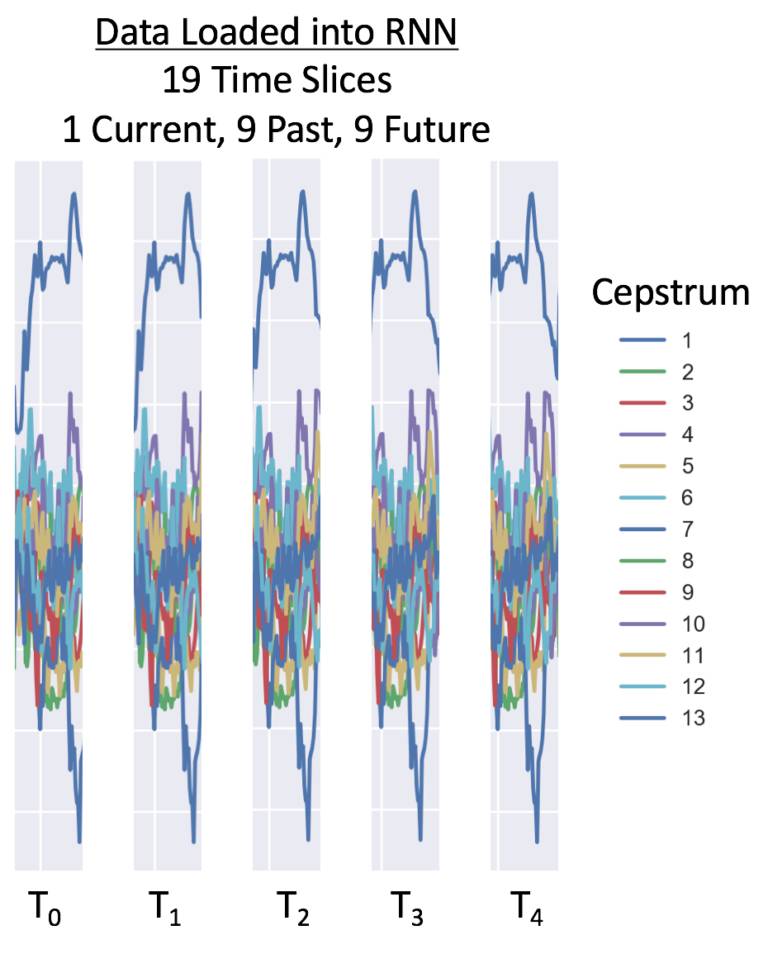wav_files =[x.replace('.txt', '.wav') forx intxt_files]
# Load audio and text into memory
(audio, text) =get_audio_and_tran(
txt_files,
wav_files,
_numcep,
_numcontext)
特征表示
为了让机器识别音频数据,数据必须先从时域转换为频域。有几种用于创建音频数据机器学习特征的方法,包括任意频率的 binning(如 100Hz),或人耳能够感知的频率的 binning。这种典型的语音数据转换需要计算 13 位或 26 位不同倒谱特征的梅尔倒频谱系数(MFCC)。在转换之后,数据被存储为时间(列)和频率系数(行)的矩阵。

因为自然语言的语音不是独立的,它们与字母也不是一一对应的关系,我们可以通过训练神经网络在声音数据上的重叠窗口(前后 10 毫秒)来捕捉协同发音的效果(一个音节的发音影响了另一个)。以下代码展示了如何获取 MFCC 特征,以及如何创建一个音频数据的窗口。
# Load wav files
fs, audio =wav.read(audio_filename)
# Get mfcc coefficients
orig_inputs =mfcc(audio, samplerate=fs, numcep=numcep)
# For each time slice of the training set, we need to copy the context this makes
train_inputs =np.array([], np.float32)
train_inputs.resize((orig_inputs.shape[0], numcep +2*numcep *numcontext))
fortime_slice inrange(train_inputs.shape[0]):
# Pick up to numcontext time slices in the past,
# And complete with empty mfcc features
need_empty_past =max(0, ((time_slices[0] +numcontext) -time_slice))
empty_source_past =list(empty_mfcc forempty_slots inrange(need_empty_past))
data_source_past =orig_inputs[max(0, time_slice -numcontext):time_slice]
assert(len(empty_source_past) +len(data_source_past) ==numcontext)
...
对于这个 RNN 例子来说,我们在每个窗口使用前后各 9 个时间点——共 19 个时间点。有 26 个倒谱系数,在 25 毫秒的时间里共 494 个数据点。根据数据采样率,我们建议在 16,000 Hz 上有 26 个倒谱特征,在 8,000 Hz 上有 13 个倒谱特征。以下是一个 8,000 Hz 数据的加载窗口:

如果你希望了解更多有关转换数字音频用于 RNN 语音识别的方法,可以看看 Adam Geitgey 的介绍:
对语音的序列本质建模
长短期记忆(LSTM)是循环神经网络(RNN)的一种,它适用于对依赖长期顺序的数据进行建模。它对于时间序列数据的建模非常重要,因为这种方法可以在当前时间点保持过去信息的记忆,从而改善输出结果,所以,这种特性对于语音识别非常有用。如果你想了解在 TensorFlow 中如何实例化 LSTM 单元,以下是受 DeepSpeech 启发的双向循环神经网络(BiRNN)的 LSTM 层示例代码:
with tf.name_scope('lstm'):
# Forward direction cell:
lstm_fw_cell =tf.contrib.rnn.BasicLSTMCell(n_cell_dim, forget_bias=1.0, state_is_tuple=True)
# Backward direction cell:
lstm_bw_cell =tf.contrib.rnn.BasicLSTMCell(n_cell_dim, forget_bias=1.0, state_is_tuple=True)
# Now we feed `layer_3` into the LSTM BRNN cell and obtain the LSTM BRNN output.
outputs, output_states =tf.nn.bidirectional_dynamic_rnn(
cell_fw=lstm_fw_cell,
cell_bw=lstm_bw_cell,
# Input is the previous Fully Connected Layer before the LSTM
inputs=layer_3,
dtype=tf.float32,
time_major=True,
sequence_length=seq_length)
tf.summary.histogram("activations", outputs)
关于 LSTM 网络的更多细节,可以参阅 RNN 与 LSTM 单元运行细节的概述:
此外,还有一些工作探究了 RNN 以外的其他语音识别方式,如比 RNN 计算效率更高的卷积层:https://arxiv.org/abs/1701.02720
训练和监测网络
转载请注明出处。
 相关文章
相关文章 精彩导读
精彩导读 热门资讯
热门资讯 关注我们
关注我们
